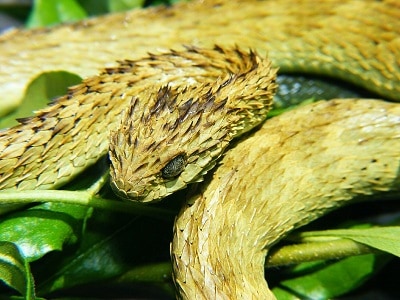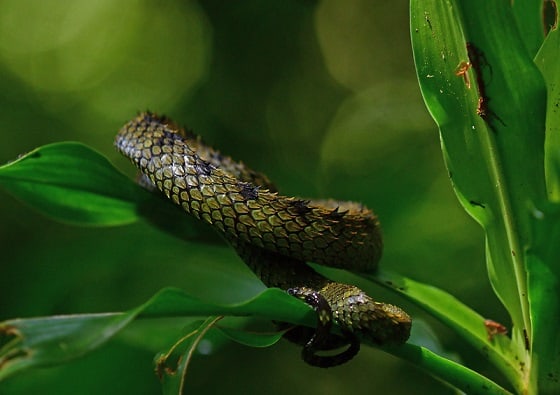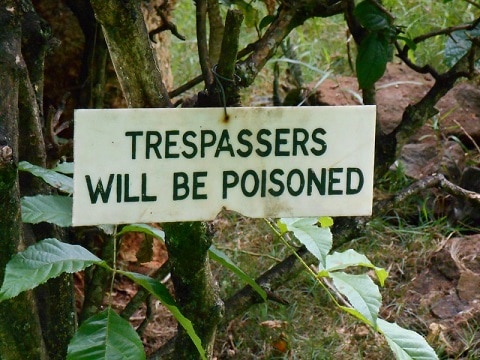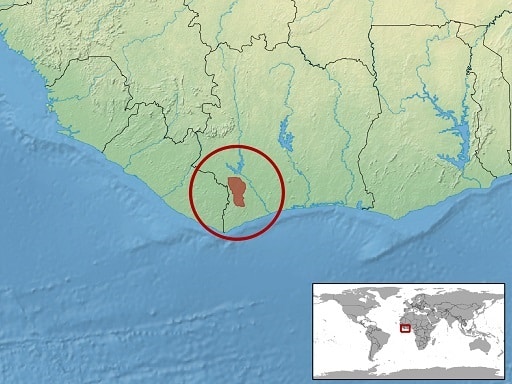| 1 | The spikiest African viper |

There are over 300 species of viper worldwide, and within that family, there are 14 confirmed members of the African bush viper genus, AKA Atheris. These venomous snakes live exclusively in Africa, and are virtually all tree snakes which spend days clinging to the same branches waiting in ambush. The most common member is the variable bush viper (Atheris squamata), which is also popular in captivity due to its wide-ranging colours. However, the freakiest-looking Atheris member of all has to be the hairy bush viper, AKA Atheris hispida.
The hairy bush viper is an uncommon species found in just 4, possibly 5 central African nations: Kenya, Uganda, DRC and Tanzania. They’re dangerously venomous, but because they live deep in jungles, bites are relatively rare, and so is data on their effects.
Atheris hispida goes by a variety of names, including hairy bush viper, rough-scaled bush viper, and spiny viper. It doesn’t take a genius to understand why, as this snake has some of the most incredible scales of any in nature. They’re so sharp and jagged that the snake seems to covered with multiple tiny horns.
Up close, this snake looks like a pineapple come to life, or a snake consisting of endless fallen leaves packed together into multiple tight rows. Each individual scale is highly elongated, so that the snake has a rare shaggy appearance. The longest scales occur at the head, and slowly (but only slowly) flatten as they move towards the tail.
| 2 | A pineapple in snake form |

In size, this is relatively small snake. Atheris hispida measures 40-60m on average, with a maximum length of 70cm and newborns being 11-14cm. Unlike the boa constrictor, males are longer but also thinner than females. Its pupils are vertical in the classic intimidating viper fashion rather than black and beady, but its irises are dark grey, and speckled with tiny black spots. Its eyes are also very large compared to most snakes.
Colourwise, this snake varies significantly between males and females. Males are a bright and vibrant olive-green, sometimes with touches of yellow. Females tend to have a duller colour, ranging from olive-brown to olive-yellow. These colours have one purpose: to help it blend in perfectly with its natural bush environment. Combined with its nocturnal habitats, the species has all the tools to stay hidden if it so wishes. This snake has a wide and triangular head, unlike some snake species, where the head is barely distinguishable from the neck in thickness.
It isn’t just the long scales that give the species such shagginess, but the fact that each individual scale curves outwards. Atheris hispida looks as though your hand would start bleeding instantly if you touched it.
| 3 | Notoriously hard to find |

There’s nobody on Earth who knows the full extent of the hairy bush viper’s range. It officially occupies 4 countries, but more new territories may be discovered soon.
For example, Rwanda doesn’t have any officially recorded sightings, but because Rwanda is sandwiched right in the middle of the range, it almost certainly lives there in secret. Specific hotspots for this species include the Minziro forest in northwest Tanzania, the Kakamega forest in Kenya, and in Uganda, the Bwindi Impenetrable National Park and Kigezi Game Reserve.
As African snakes go, Atheris hispida isn’t as widespread as the notorious black mamba, as it never occurs down in South Arica or Swaziland. But that said, new pockets of range are constantly being discovered. In 2018, scientists extended the species’ range by spotting 2 females in Mityana District, located in southeast Uganda. This new sighting was 235km from the nearest known sighting in one direction, and 255km in the other. Said the scientists: “we deem it likely that more isolated populations of A. hispida have yet to be recorded“.
| 4 | Requires forest to survive |
The hairy bush viper is a creature of the hot and humid forests, the sort of vegetation which explorers have to plough their way through with immense caution. It’s rarely found in open fields and instead loves spots where the ground vegetation climbs to the knees. The hairy bush viper prefers bushes which are medium in height, from 2-3 metres, and this preference probably evolved around their camouflaged colour or vice versa. It loves thicket and tangled vines, and can be found at 700-2400 meters in altitude.
Secondary rainforests and rainforests are both acceptable, but some sort of forest is essential. The species isn’t particularly flexible, coping poorly with deforested areas or fields. But they can sometimes be found next to water bodies within forests, and moistness is important for them in general.
The only problem with the species’ wood-loving nature is vulnerability to deforestation. In fact, that’s probably the reason for so many isolated pockets in its range, with the forests inbetween being mercilessly slashed down. Kenya and Uganda have extremely rapid rates of deforestation, as much as 6.6% per year in Uganda. For now, atheris hispida isn’t officially on the ICUN endangered list.
| 5 | Effortlessly climbs thin branches |

Restricted it may be, but within its forest habitat, the hairy bush viper is the absolute master. Looking like a pineapple has its advantages occasionally, and the species’ sharply keeled scales are optimal for digging into trees and performing 180 degree ascents. The species is a master tree climber on par with the Japanese ratsnake, or the golden tree snake of Thailand.
In fact, it’s particularly skilful at climbing thinner vegetation such as reeds and rainforest stalks, the sort of vegetation your foot would instantly snap. Hairy bush vipers are known to bask in flowers at the very summit of plants, warming up their cold-blooded reptilian bodies. Scientists have observed that in the Kakamega forest of Kenya, where they co-exist with the green bush viper, the hairy bush viper tends to be much higher up on average.
Their hunting techniques are in line with most climbing snakes, as they hang from branches, waiting for prey to pass. Then they swing down from the branch in a fast and fluid motion, enveloping their unsuspecting prey. The prey has no chance to tell when death is looming over its head because of the snake’s amazing camouflage.
| 6 | Believed to prey on snails |
There’s almost no research on the precise diet of this species. It’s easily the largest blank spot in the species’ record, with one of the few observations in scientific literature revealing that a snail was once found in its stomach. Much of the information we have comes from amateur enthusiasts, who generally believe that the species is a specialised feeder on slugs and worms.
The hairy bush viper is extremely difficult to breed in captivity, generally refusing to eat, but one amateur breeder kept a hairy bush viper alive for 6 months by feeding it yellow slugs. By winter, the slugs had disappeared from his garden, and the snake succumbed to starvation. Other breeders have fed them frogs to success, but most reptile enthusiasts are convinced that they like smaller food.
There’s a handful of observations from the Kakamega forest of Kenya, where they’ve been observed eating tree frogs and rodents. It’s possible that this snake isn’t particularly fussy. It may be a less specific hunter than the asp viper of France, with its vole obsession, or the Antiguan racer, which is a confirmed lizard muncher.
| 7 | Deadlier than once thought |
You’re lost in the humid forests of Kenya, slashing your way forward with machete in hand. You stumble into an area you swear you’ve visited before, and see what looks like a children’s toy on a branch. You admire it for a second, before what turns out to be a snake pulls its neck back and hisses. It springs forward, and no matter how fast you sidestep, its fans still pierce your arm.
That’s how the story would probably go if you were bitten by this species, but how potent is its venom? It was once believed to be mild, but over the last decade, numerous reports of human death have trickled in. African countries have reported severely haemorrhaging internal organs, and the venom is particularly dense with neurotoxins. There’s also toxins called fasciculins, which are normally the reserve of mamba species, and specialise in muscle spasms.
Supposedly, hairy bush viper venom varies massively from snake to snake, being influenced by weather, geographical location, or even plain old genetics. The evillest fact of all is that like other bush vipers, there’s no known antivenom, one of the few species for which that’s the case.
| 8 | Their western cousin |

Believe it or not, the hairy bush viper has a skill other than biting people – identify theft. There’s actually another species known colloquially as the hairy bush viper, which is called the Tai hairy bush viper. Its official name is atheris hirsuta, one of 17 members of the atheris family, but information is far scarcer, mainly because it was only identified in 2002. For years, it was known only from two male snakes which measured 43cm and 48cm long. One was spotted on a road while the other was seen in a forest.
Its spiky appearance resembles the “main” hairy bush viper closely, with a few differences. Firstly, its scales are less angled, giving it a fuzzier look. Secondly, it scales tend to be bronzer and darker.
Finally, it has particularly gigantic eyes, and its body particularly thin relative to its head. This is a snake you almost want to whip somebody with. It also lives in southern west Africa rather than Mideast Africa, and specifically the countries of Liberia and the Ivory Coast. Scientists consider this species to be the real hairy bush viper and not the one we’re discussing today, because the word “hirsutus” translates to hairy in the Latin language. 200
| 9 | Impossible to breed in captivity |
The hairy bush viper is commonly debated on reptile enthusiast forums, as it’s a notoriously difficult species to keep. The vast majority die within weeks, or even days. As imported snakes, they often sit for days in hot, stuffy containers as they travel slowly to western countries. Once in the hands of reptile enthusiasts, they’re normally in poor conditions, riddled with parasites such as lung worms. It’s also challenging to mimic their bushy, vegetated habitat, and it’s recommended to keep a cage with different floors to allow them to climb.
One forum poster mentioned a Finnish man who had successfully kept a female for three years, and more hopeful people mention how bushmasters were originally considered impossible to keep as well. There’s many pieces of advice, such as releasing mist only twice per week, and placing aluminium gravel at the bottom of the subadult’s jar. As it stands, hairy bush vipers can’t compare to the corn snake as a low effort best friend which you can simply chuck a few frozen mice to each month.
| 10 | Fires insects at people? |
Many of the most vicious snakes look mundane rather than bright and colourful. Not this snake – it matches its deadly venom and fabulous pineapple appearance with the vicious temperament of a sentient battle axe. When picked up, it refuses to play dead like the peaceful grass snake. Instead, it bites its aggressor viciously, sinking its fangs into the flesh and writhing its body back and forth.
Numerous first hand report insist that it spews black mites from its mouth as it attempts to escape, like a minion of Imhotep from The Mummy. When feeling threatened, it tends to coil its body in C-shaped coils. It’s also a fast-moving snake, when found in its native habitat of high trees and branches.
Luckily for explorers, atheris hispida is mostly nocturnal, but the species will still strike at passing prey during the daytime. Sometimes, the snake may not be there at all. It’s said that in Kakamega forest (possibly the location where it’s most studied), its population cycle is like a rollercoaster. One year, they’ll be abundant, the next year their numbers will crash, and the year after, they’ll mysteriously be healthy again. The causes of this are unknown.
